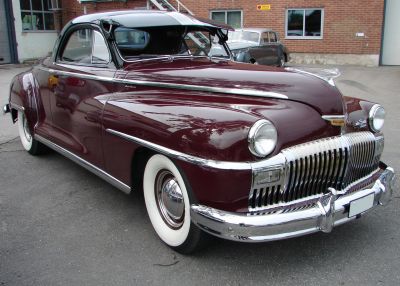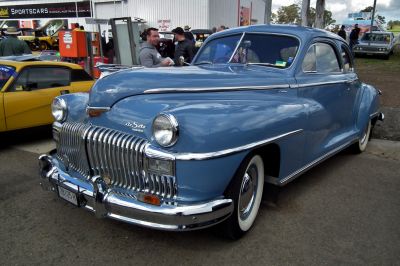 1946 DeSoto Custom Convertible Club Coupe Dimensions, Size & Specs
1946 DeSoto Custom Convertible Club Coupe Dimensions, Size & SpecsMeasurements of the 1946 DeSoto Custom Convertible Club Coupe, engineered for optimal performance and comfort
| Dimensions | |
|---|---|
| Length: | 5265 mm207.3 in17.3 ft |
| Width: | 1923 mm75.7 in6.3 ft |
| Height: | 1687 mm66.4 in5.5 ft |
The DeSoto Custom Convertible Club Coupe, produced from 1946 through 1949, represents a distinguished model generation from the post-World War II era, combining classic American styling with robust dimensions. Measuring 5265 mm (207.3 inches) in length, the DeSoto Custom offers a commanding presence on the road, reflecting its design focus on spaciousness and comfort. With a width of 1923 mm (75.7 inches), this vehicle provided ample room for occupants, enhancing ride quality and interior space, while its height of 1687 mm (66.4 inches) contributed to a balanced, elegant profile typical of late 1940s American cabriolets and coupes. The Custom Convertible Club Coupe was available as both a cabriolet and coupe, blending luxury and performance for discerning drivers of the era. Its dimensions underscored DeSoto’s commitment to producing vehicles that combined style, utility, and ample passenger comfort, making it a notable example of American automotive design during the immediate postwar years.
Discover the standout features that make the 1946 DeSoto Custom Convertible Club Coupe a leader in its class
Have a question? Please check our knowledgebase first.
The 1946-1949 DeSoto Custom Convertible Club Coupe measures 5265 mm (207.3 inches) in length, 1923 mm (75.7 inches) in width, and 1687 mm (66.4 inches) in height. These dimensions give it a substantial road presence typical of luxury and custom vehicles of the post-war era, providing ample interior space and a distinctive classic automotive silhouette.
The DeSoto Custom Convertible Club Coupe has a width of 1923 mm (75.7 inches). This considerable width was designed to offer spacious seating inside the cabin, contributing to a comfortable ride for passengers. Additionally, the broad stance helps with road stability and handling, particularly important since this vehicle was built during an era when road conditions were less uniform than today.
The vehicle stands at 1687 mm (66.4 inches) tall. Compared to modern cars, this height is somewhat taller than most contemporary convertibles and coupes, allowing for a more commanding driving position and greater headroom. The taller design is characteristic of American cars from the 1940s, which often favored comfort and status with larger, more upright cabins.
Measuring 5265 mm (207.3 inches) in length, the DeSoto Custom Convertible Club Coupe is quite long by any standard. This length provides significant interior space and a grand presence but can pose challenges when parking or maneuvering in tight spaces, especially in modern urban environments. Drivers of this classic car often need more space to navigate around obstacles compared to today's smaller, more compact vehicles.
Standard modern garages typically range around 2.44 m (8 feet) in width and 5.5 to 6 m (18 to 20 feet) in depth. Given that the DeSoto Custom Convertible Club Coupe is 1923 mm (75.7 inches or approximately 6.3 feet) wide and 5265 mm (207.3 inches or roughly 17.3 feet) long, it generally fits within the depth of a typical garage but might be a tight fit in terms of width, especially considering room needed for opening doors. Overall, parking the vehicle in a standard garage is possible but may require careful maneuvering.
Compared to its pre-war predecessors, the 1946 DeSoto Custom Convertible Club Coupe was larger in overall dimensions, reflecting a trend toward more spacious and luxurious vehicles following World War II. Earlier models were generally shorter and less wide, as manufacturing focused more on efficiency and less on passenger comfort. The post-war DeSoto addressed market desires for a more commanding road presence and greater interior space, thus gaining several hundred millimeters in length and width.
In comparison to other American convertibles from the late 1940s, such as the Chrysler Windsor Convertible or the Cadillac Series 62 Convertible, the DeSoto Custom Convertible Club Coupe occupies a very competitive space. It is similarly lengthy and wide, designed to provide luxury and comfort. While some competitors might have been fractionally longer or wider, DeSoto's wheelbase, width, and overall size ensured it held its own as an upscale vehicle targeting affluent buyers seeking both style and interior space.
The DeSoto Custom Custom Convertible Club Coupe was available primarily as a cabriolet (convertible) and a coupe. These body styles highlighted the blend of luxury and stylish design that DeSoto aimed to achieve in the post-war market. The convertible offered open-air driving appeal, while the coupe featured a sleeker silhouette with a fixed roof, both built on the same substantial chassis dimensions.
With its long length of 5265 mm (207.3 inches) and broad width of 1923 mm (75.7 inches), the DeSoto Custom Convertible Club Coupe offers generous passenger room that was highly competitive for its era. The vehicle’s dimensions ensured spacious seating for all occupants, including adequate legroom and shoulder room. Its height of 1687 mm (66.4 inches) further promotes a comfortable cabin environment with sufficient headroom—an important factor in luxury vehicles where comfort was a priority.
The DeSoto Custom Convertible Club Coupe exemplifies the post-World War II trend toward larger, more luxurious cars with an emphasis on comfort and status. Its sizable dimensions—over 5.2 meters in length and nearly 2 meters wide—were typical of American cars in this era, which prioritized spacious interiors and a commanding road presence. The convertible and coupe body styles reflect consumer desires for stylish, elegant designs that combined performance with luxury, marking DeSoto’s position as a prestige brand during those years.
Discover similar sized cars.

| Production: | 1946-1949 |
|---|---|
| Model Year: | 1946 |
| Length: | 5265 mm207.3 in |
| Width: | 1923 mm75.7 in |
| Height: | 1687 mm66.4 in |

| Production: | 1946-1949 |
|---|---|
| Model Year: | 1946 |
| Length: | 5265 mm207.3 in |
| Width: | 1923 mm75.7 in |
| Height: | 1687 mm66.4 in |
